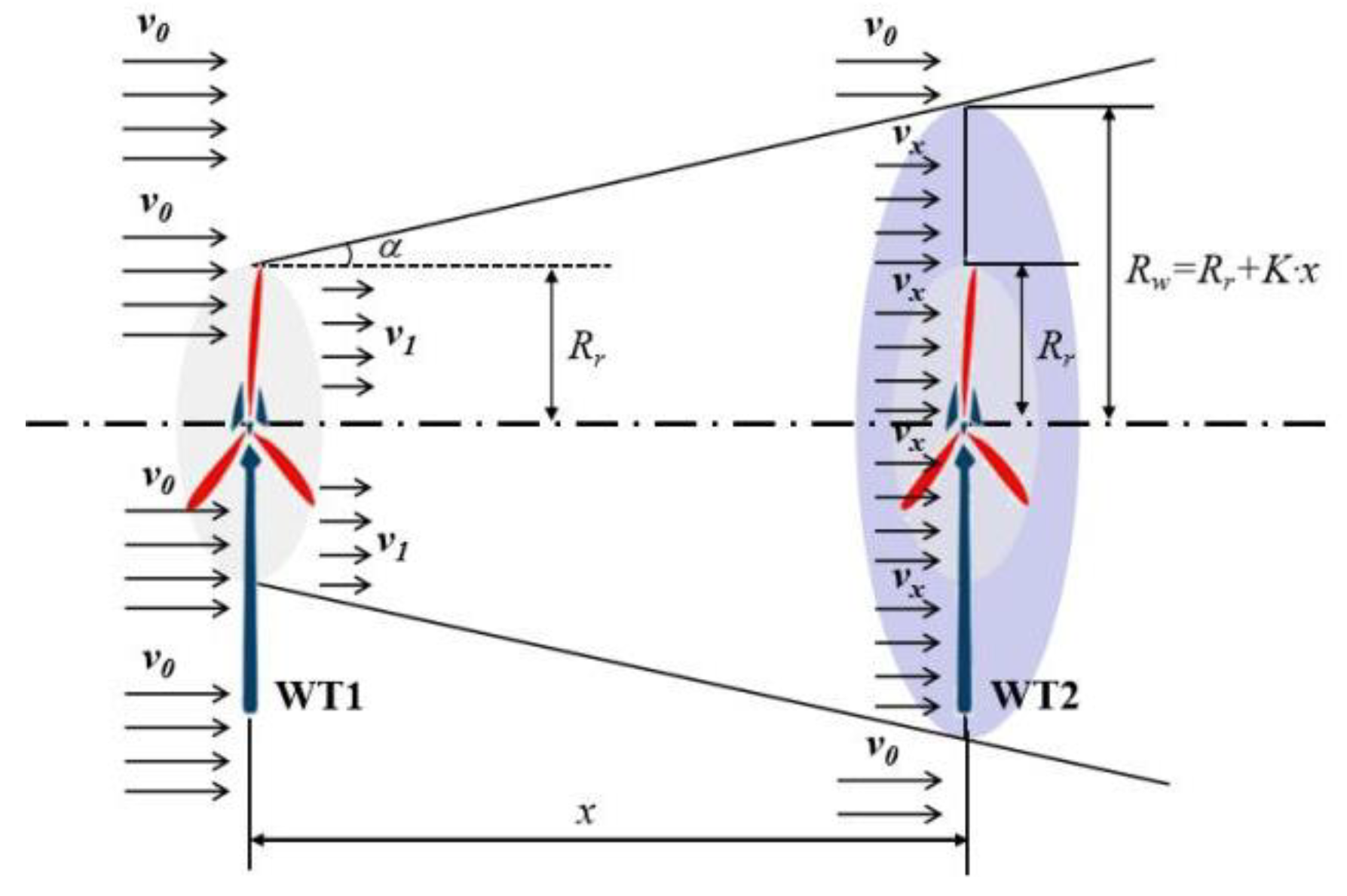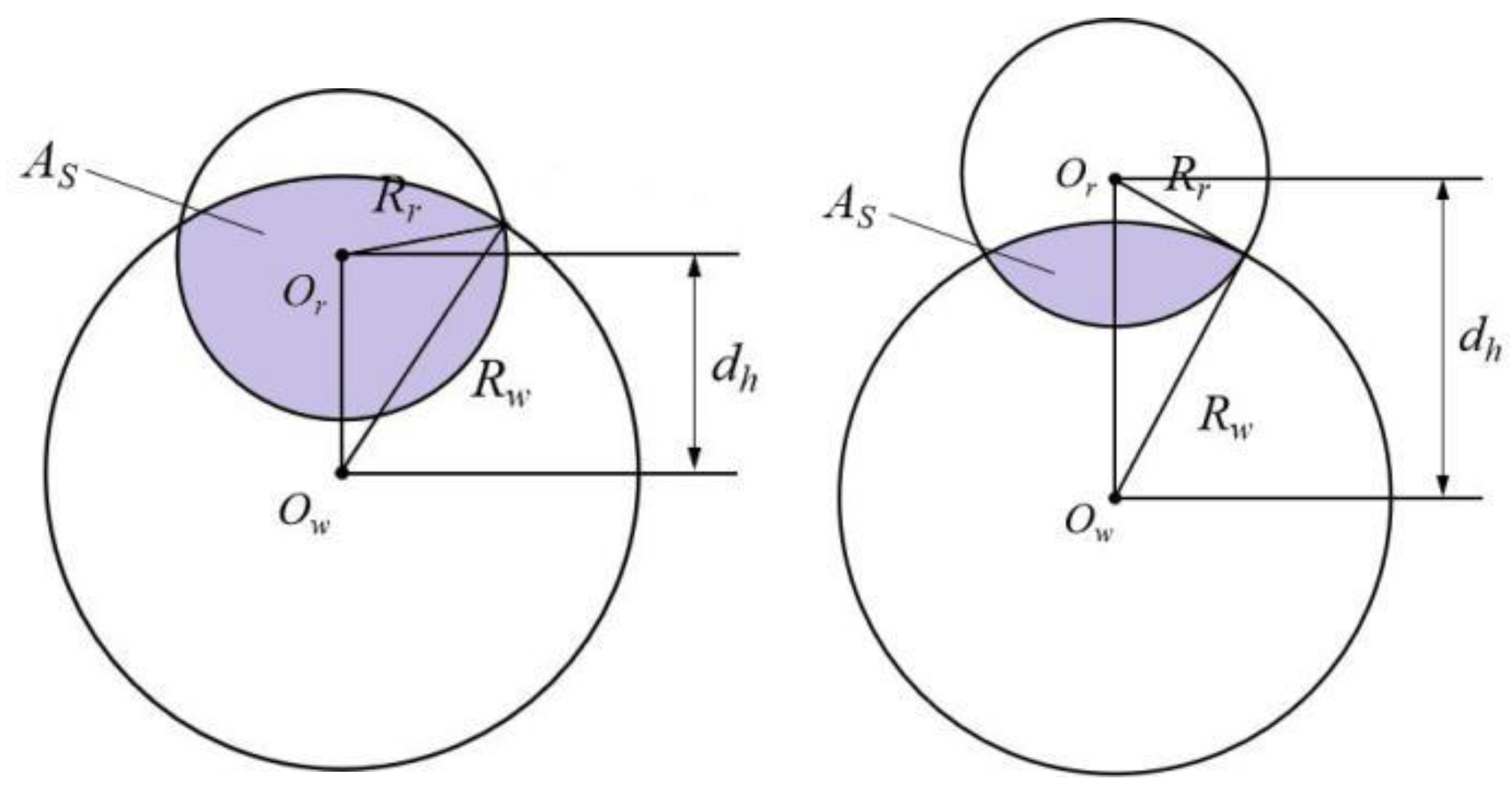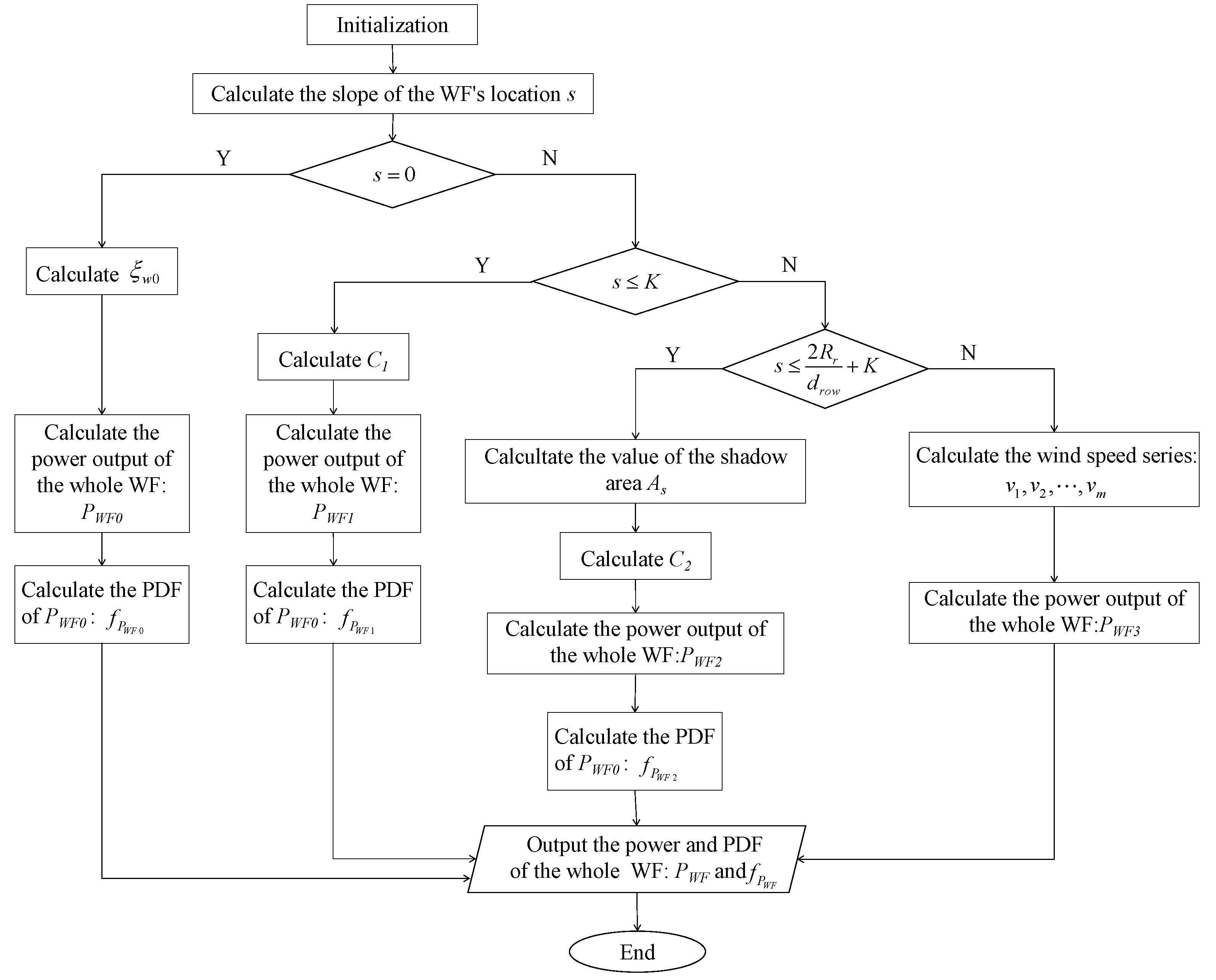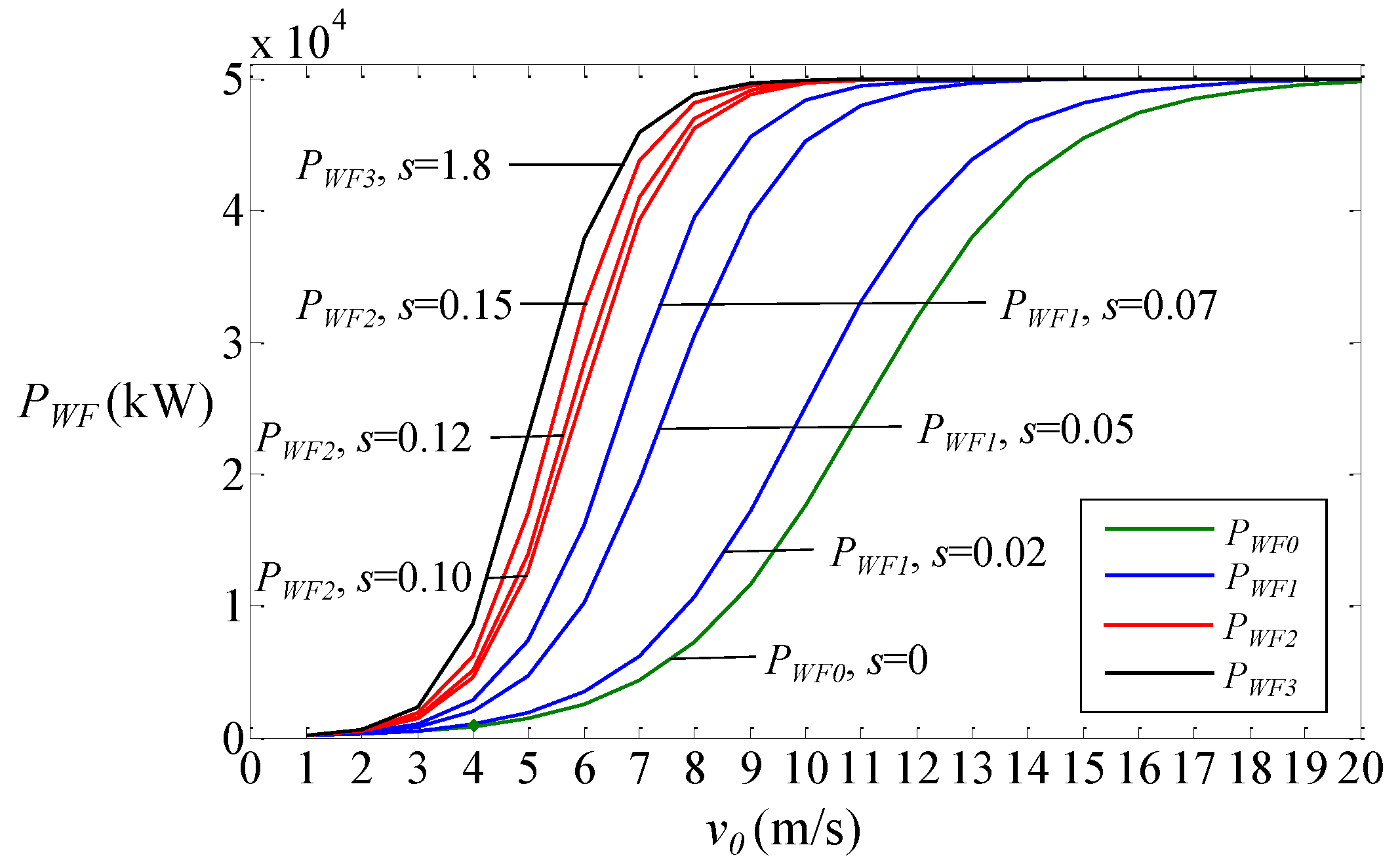Integrated Wind Farm Power Curve and Power Curve Distribution Function Considering the Wake Effect and Terrain Gradient
Abstract
:1. Introduction
2. Wake Analysis
2.1. Wake Model
2.2. Shear Effect
2.3. Wake Analysis and Terrain Gradient
3. WF PDF
3.1. 3-P WT PDF Model
3.2. 3-P WF PDF Model
3.3. WF Power PDF
3.4. Implementation of the WF Output Power Calculation Function
- Step 1
- Initialization of the program and input of all the parameters.
- Step 2
- Calculation of the terrain’s slope to determine the scenario.
- Step 3
- Calculation of the whole WF’s output power using the model for the scenario.
- Step 4
- Calculation of the WF output power’s PDF.
- Step 5
- Output of the calculated power and PDF of the whole WF.
4. Case Study
4.1. Simulation of the WF Power Curve Functions
4.2. Validation by Means of Monte Carlo Simulations
5. Conclusions
- (i)
- The scenario where the gradient is extremely steep needs to be studied. The condition of inflow air and outflow air requires detailed analyses, especially when the WTs’ blades are quite close to the mountain “wall”. The corresponding PDF in scenario 4 should be derived.
- (ii)
- This approximate computation model can only be applied to WFs with a certain orderly arrangement (identical drow for all rows). Improvements and also a challenge for future work is to consider not only more irregular WF layouts but more complex terrains as well.
- (iii)
- Wind from all directions was not taken into account in this model. Since the level of symmetry assumed is not always consistent with the real scenario, it should be combined with the contribution proposed in [25] and a more accurate model developed accordingly.
- (iv)
- A more accurate wake model could be used, instead of Jensen’s wake model, for obtaining the WF power curve such as the Gaussian wake model proposed in [2].
- (v)
- Real measurements on WFs using light detection and ranging (LiDAR) technique should be used, in the future, to test the proposed model instead of only simulations.
- (vi)
- Wind speed correlations between different locations of WTs inside a WF [33] should be considered for wind dynamics analysis instead of only one-point statistics.
Author Contributions
Funding
Acknowledgments
Conflicts of Interest
Nomenclature
| Abbreviation | |||
| WF | wind farm | ||
| 3-P | three-parameter | ||
| WT | wind turbine | ||
| probability density function | |||
| CDF | cumulative distribution function | ||
| LiDAR | light detection and ranging | ||
| Notation | |||
| Rr | WT blade length | drow | the distance between two adjacent rows |
| Rw | the radius of the wake area | wake coefficient when WF is on a flat area | |
| ρ | air density | dh | height difference of two WTs |
| v0 | ambient wind speed | H | hill’s height |
| K | wake decay constant | L | hill’s length |
| wake coefficient | AS | wake overlap area | |
| Ct | WT thrust coefficient | Pr | WT rated power |
| v(z) | wind speed at height z | sv | the slope at the inflection point of the WT power curve |
| zref | wind speed measured height | vip | wind speed at the inflection point of the WT power curve |
| approximation coefficient of wind shear | C | scale parameter of Weibull distribution | |
| a | total number of rows of the WF | k | shape parameter of Weibull distribution |
| b | Total number of columns of the WF | equivalent wake effect coefficient of the WF over a hill with gentle gradient | |
| s | terrain gradient | equivalent wake effect coefficient of the WF over a hill with medium gradient | |
References
- Yang, H.J.; Xie, K.G.; Tai, H.M.; Chai, Y. Wind farm layout optimization and its application to power system reliability analysis. IEEE Trans. Power Syst. 2016, 31, 2135–2143. [Google Scholar] [CrossRef]
- Tao, S.Y.; Kuenzel, S.; Xu, Q.S.; Chen, Z. Optimal micro-siting of wind turbines in an offshore wind farm using Frandsen-Gaussian wake model. IEEE Trans. Power Syst. 2019. [CrossRef]
- Papatheou, E.; Dervilis, N.; Maguire, A.E.; Antoniadou, I.; Worden, K. A performance monitoring approach for the novel Lillgrund offshore wind farm. IEEE Trans. Ind. Electron. 2015, 62, 6636–6644. [Google Scholar] [CrossRef]
- Kusiak, A.; Zheng, H.; Song, Z. On-line monitoring of power curves. Renew. Energy 2009, 34, 1487–1493. [Google Scholar] [CrossRef]
- Kusiak, A.; Zheng, H.; Song, Z. Models for monitoring wind farm power. Renew. Energy 2009, 34, 583–590. [Google Scholar] [CrossRef]
- Xu, J.; Yi, X.K.; Sun, Y.Z.; Lan, T.K.; Sun, H. Stochastic optimal scheduling based on scenario analysis for wind farms. IEEE Trans. Sustain. Energy 2017, 8, 1548–1559. [Google Scholar] [CrossRef]
- Khalid, M.; Savkin, A.V. A method for short-term wind power prediction with multiple observation points. IEEE Trans. Power Syst. 2012, 27, 579–586. [Google Scholar] [CrossRef]
- Zhao, Y.N.; Ye, L.; Pinson, P.; Tang, Y.; Lu, P. Correlation-constrained and sparsity-controlled vector autoregressive model for spatio-temporal wind power forecasting. IEEE Trans. Power Syst. 2018, 33, 5029–5040. [Google Scholar] [CrossRef]
- Baros, S.; Ilić, M.D. Distributed torque control of deloaded wind DFIGs for wind farm power output regulation. IEEE Trans. Power Syst. 2017, 32, 4590–4599. [Google Scholar] [CrossRef]
- Ahmad, T.; Coupiac, O.; Petit, A.; Guignard, S.; Girard, N.; Kazemtabrizi, B.; Matthews, P.C. Field Implementation and trial of coordinated control of wind farms. IEEE Trans. Sustain. Energy 2018, 9, 1169–1176. [Google Scholar] [CrossRef]
- Li, D.Y.; Li, P.; Cai, W.C.; Song, Y.D.; Chen, H.J. Adaptive fault-tolerant control of wind turbines with guaranteed transient performance considering active power control of wind farms. IEEE Trans. Ind. Electron. 2018, 65, 3275–3285. [Google Scholar] [CrossRef]
- Guo, Y.; Kabamba, P.T.; Meerkov, S.M. Quasilinear control of wind farm power output. IEEE Trans. Control Syst. Technol. 2015, 23, 1555–1562. [Google Scholar] [CrossRef]
- Tian, J.; Zhou, D.; Su, C.; Soltani, M.; Chen, Z.; Blaabjerg, F. Wind turbine power curve design for optimal power generation in wind farms considering wake effect. Energies 2017, 10, 395. [Google Scholar] [CrossRef]
- Lydia, M.; Selvakumar, A.I.; Kumar, S.S. Advanced algorithms for wind turbine power curve modeling. IEEE Trans. Sustain. Energy 2013, 4, 827–835. [Google Scholar] [CrossRef]
- Sim, S.K.; Maass, P.; Lind, P.G. Wind speed modeling by nested ARIMA processes. Energies 2019, 12, 69. [Google Scholar] [CrossRef]
- Thapar, V.; Agnihotri, G.; Sethi, V.K. Critical analysis of methods for mathematical modeling of wind turbines. Renew. Energy 2011, 36, 3166–3177. [Google Scholar] [CrossRef]
- Ustuntas, T.; Sahin, A.D. Wind turbine power curve estimation based on cluster center fuzzy logic modeling. J. Wind Eng. Ind. Aerodyn. 2008, 96, 611–620. [Google Scholar] [CrossRef]
- Pelletier, F.; Masson, C.; Tahan, A. Wind turbine power curve modelling using artificial neural network. Renew. Energy 2016, 89, 207–214. [Google Scholar] [CrossRef]
- Ouyang, T.H.; Kusiak, A.; He, Y.S. Modeling wind-turbine power curve: A data partitioning and mining approach. Renew. Energy 2017, 102, 1–8. [Google Scholar] [CrossRef]
- Zhao, Y.N.; Ye, L.; Wang, W.S.; Sun, H.D.; Ju, Y.T.; Tang, Y. Data-driven correction approach to refine power curve of wind farm under wind curtailment. IEEE Trans. Sustain. Energy 2018, 9, 95–105. [Google Scholar] [CrossRef]
- Shi, L.B.; Weng, Z.X.; Yao, L.Z.; Ni, Y.X. An analytical solution for wind farm power output. IEEE Trans. Power Syst. 2014, 29, 3122–3123. [Google Scholar] [CrossRef]
- Villanueva, D.; Feijóo, A. Reformulation of parameters of the logistic function applied to power curves of wind turbines. Electr. Power Syst. Res. 2016, 28, 51–58. [Google Scholar] [CrossRef]
- Feijóo, A.; Villanueva, D. Wind farm power distribution function considering wake effects. IEEE Trans. Power Syst. 2017, 32, 3313–3314. [Google Scholar] [CrossRef]
- Feijóo, A.; Villanueva, D. Four parameter models for wind farm power curves and power probability density functions. IEEE Trans. Sustain. Energy 2017, 8, 1783–1784. [Google Scholar] [CrossRef]
- Feijóo, A.; Villanueva, D. Contributions to wind farm power estimation considering wind direction-dependent wake effects. Wind Energy 2017, 20, 221–231. [Google Scholar] [CrossRef]
- Jensen, N.O. A Note on Wind Generator Interaction, RisØ M-2411; Risø National Laboratory: Roskilde, Denmark, 1983. [Google Scholar]
- Katić, I.; Højstrupm, J.; Jensen, N.O. A simple model for cluster efficiency. In Proceedings of the European Wind Energy Association Conference and Exhibition, Rome, Italy, 7–9 October 1986. [Google Scholar]
- Schallenberg-Rodriguez, J. A methodological review to estimate techno-economical wind energy production. Renew. Sustain. Energy Rev. 2013, 21, 272–287. [Google Scholar] [CrossRef]
- Han, X.Q.; Qu, Y.; Wang, P.; Yang, J.H. Four-dimensional wind speed model for adequacy assessment of power systems with wind farms. IEEE Trans. Power Syst. 2013, 28, 2978–2985. [Google Scholar] [CrossRef]
- Betz, A. Das maximum der theoretisch möglichen ausnutzung des windes durch windmotoren. Gesamte Turbinenwesen 1920, 20, 307–315. [Google Scholar]
- Stuart, A.; Ord, K. Kendall’s Advanced Theory of Statistics, 6th ed.; Oxford University Press: Oxford, UK, 1994; Volume I. [Google Scholar]
- Fishman, G.S. Monte Carlo: Concepts, Algorithms, Applications; Springer: New York, NY, USA, 1995. [Google Scholar]
- Raischel, F.; Scholz, T.; Lopes, V.V.; Lind, P.G. Uncovering wind turbine properties through two-dimensional stochastic modeling of wind dynamics. Phys. Rev. E 2013, 88, 042146. [Google Scholar] [CrossRef] [Green Version]










| Ct | K | Rr [m] | drow [m] | Pr [kW] | Pip [kW] | vip [m/s] | sv [kW·s·m−1] | z0 [m] | zref [m] |
|---|---|---|---|---|---|---|---|---|---|
| 0.2 | 0.075 | 40 | 400 | 2000 | 1091.2 | 9.37 | 313.7514 | 0.3 | 10 |
© 2019 by the authors. Licensee MDPI, Basel, Switzerland. This article is an open access article distributed under the terms and conditions of the Creative Commons Attribution (CC BY) license (http://creativecommons.org/licenses/by/4.0/).
Share and Cite
Tao, S.; Xu, Q.; Feijóo, A.; Kuenzel, S.; Bokde, N. Integrated Wind Farm Power Curve and Power Curve Distribution Function Considering the Wake Effect and Terrain Gradient. Energies 2019, 12, 2482. https://doi.org/10.3390/en12132482
Tao S, Xu Q, Feijóo A, Kuenzel S, Bokde N. Integrated Wind Farm Power Curve and Power Curve Distribution Function Considering the Wake Effect and Terrain Gradient. Energies. 2019; 12(13):2482. https://doi.org/10.3390/en12132482
Chicago/Turabian StyleTao, Siyu, Qingshan Xu, Andrés Feijóo, Stefanie Kuenzel, and Neeraj Bokde. 2019. "Integrated Wind Farm Power Curve and Power Curve Distribution Function Considering the Wake Effect and Terrain Gradient" Energies 12, no. 13: 2482. https://doi.org/10.3390/en12132482






